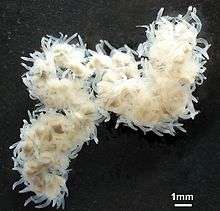Polypodium hydriforme
| Polypodium hydriforme | |
|---|---|
 | |
| Two specimens of free-living Polypodium | |
| Scientific classification | |
| Kingdom: | Animalia |
| Phylum: | Cnidaria |
| Class: | Polypodiozoa Raikova, 1994 |
| Family: | Polypodiidae |
| Genus: | Polypodium Ussov, 1885[1] |
| Species: | P. hydriforme |
| Binomial name | |
| Polypodium hydriforme (Ussov, 1885) | |
Polypodium hydriforme is a species of parasite attacking the eggs of sturgeon and similar fishes (Acipenseridae and Polyodontidae). It is one of few metazoans living inside the cells of other animals.
Polypodium hydriforme is the only species in the monotypic genus Polypodium. It is also the only species and genus within the whole family Polypodiidae.
Taxonomy
Unusual characteristics have led to much controversy regarding its phylogenetic position within metazoans.[2]
Polypodium has traditionally been considered a cnidarian because it possesses nematocysts, the stinging structures characteristic of this phylum.[2]
However, molecular phylogenetic studies using 18S rDNA sequence data have challenged this interpretation, and have indicated that Polypodium is a close relative to myxozoans and that together they share a closer affinity to bilaterians than cnidarians (Zrzavý & Hypša 2003).[3] Due to the variable rates of 18S rDNA sequences, these results have been suggested to be an artifact of long branch attraction.[2]
Evans et al. (2008)[2] have performed phylogenetic analyses of metazoans with 18S and partial 28S rDNA sequences in a large dataset that includes Polypodium and a comprehensive sampling of cnidarian taxa. This support the placement of Polypodium within Cnidaria.[2] This accords with the fact that Polypodium possesses nematocysts and a cnidarian-like body plan.[2] The ML combined analysis places Polypodium as its own class Polypodiozoa.[2] By contrast, the combined parsimony analysis and the ML analyses of 28S alone place Polypodium within the hydrozoan clade Leptothecata.[2]
Description and life cycle

Polypodium hydriforme is an endocellular parasite with unusual life cycle, peculiar morphology, and high rates of DNA evolution.[2] Polypodium spends most of its life inside the oocytes of acipenseriform fishes (sturgeons and paddlefish).[2] Its hosts include Acipenser ruthenus, Polyodon spathula and Scaphirhynchus platorynchus.[2] During this time, Polypodium develops from a binucleate cell into an inside-out planuliform larva and then into an elongate inside-out stolon; the epidermal cell layer is located internal to the body and the gastrodermis is located externally.[2] The embryo, larva and stolon are surrounded by a protective polyploid cell, which also functions in digestion.[2] Just prior to host spawning, Polypodium everts to the normal position of cell layers, revealing tentacles scattered along the stolon.[2] During eversion, the yolk of the host oocyte fills the gastral cavities of the parasite, supplying the future free-living stage with nutrients.[2] Finally, upon emerging from the host egg in fresh water, the free-living stolon fragments into individual medusoid-like forms that go on to multiply by means of longitudinal fission, form sexual organs, and ultimately infect host fish with their gametophores.[2]
Habitat
Habitat of Polypodium hydriforme is freshwater.[2]
Although the fresh water habitat of Polypodium is unusual for cnidarians, it is not unheard of, especially within hydrozoans.[2] For instance, the model organism Hydra and the jellyfish Craspedacusta sowerbii are both exclusively fresh-water hydrozoans.[2] Hydra and Craspedacusta sowerbii are distantly related and they are not closely related to Polypodium. Thus, it appears that in the evolution of cnidarians, invasion to fresh-water habitats has happened at least three separate times.[2]
References
This article incorporates CC-BY-2.0 text from the reference.[2]
| Wikimedia Commons has media related to Polypodium hydriforme. |
- ↑ Usov (1885). Trudy Obschtsch. est. Imp. Kasan. Univ. 14, Abt. 6: 1.
- 1 2 3 4 5 6 7 8 9 10 11 12 13 14 15 16 17 18 19 20 21 Evans N. M., Lindner A., Raikova E. V., Collins A. G. & Cartwright P. (2008). "Phylogenetic placement of the enigmatic parasite, Polypodium hydriforme, within the Phylum Cnidaria". BMC Evolutionary Biology. 8: 139. doi:10.1186/1471-2148-8-139. PMC 2396633
 . PMID 18471296.
. PMID 18471296. - ↑ Zrzavý J. & Hypša V. (2003). "Myxozoa, Polypodium, and the origin of the Bilateria: The phylogenetic position of "Endocnidozoa" in light of the rediscovery of Buddenbrockia". Cladistics 19(2): 164–169. doi:10.1111/j.1096-0031.2003.tb00305.x